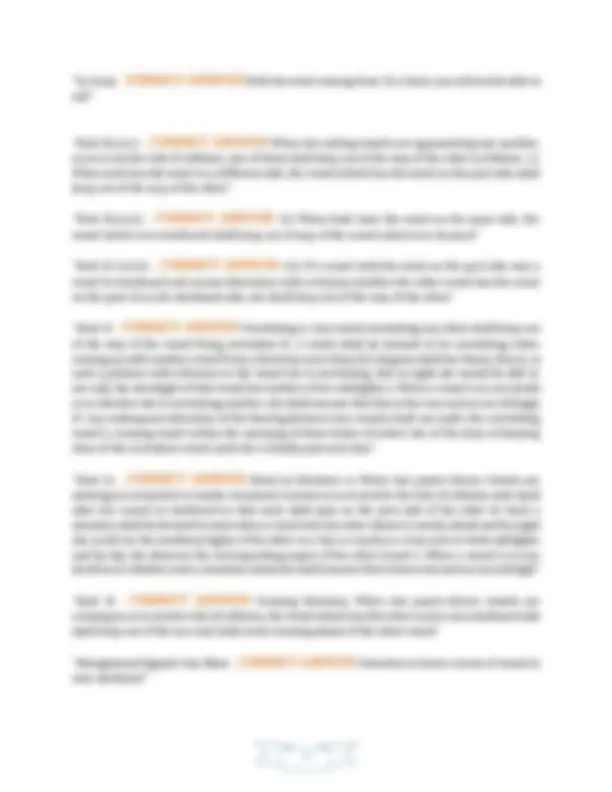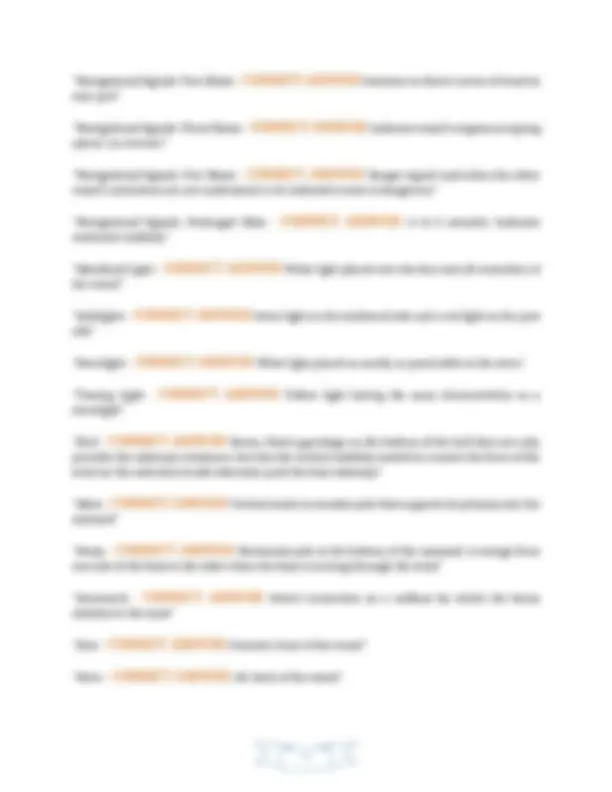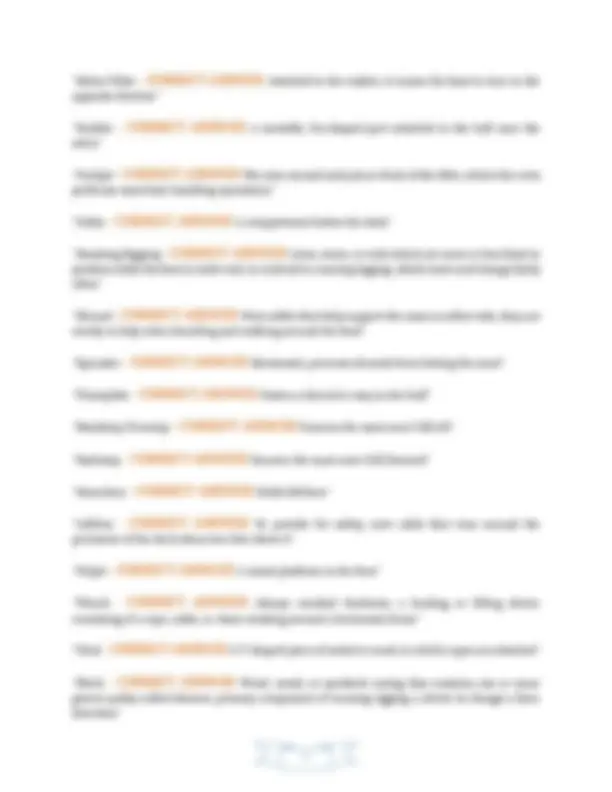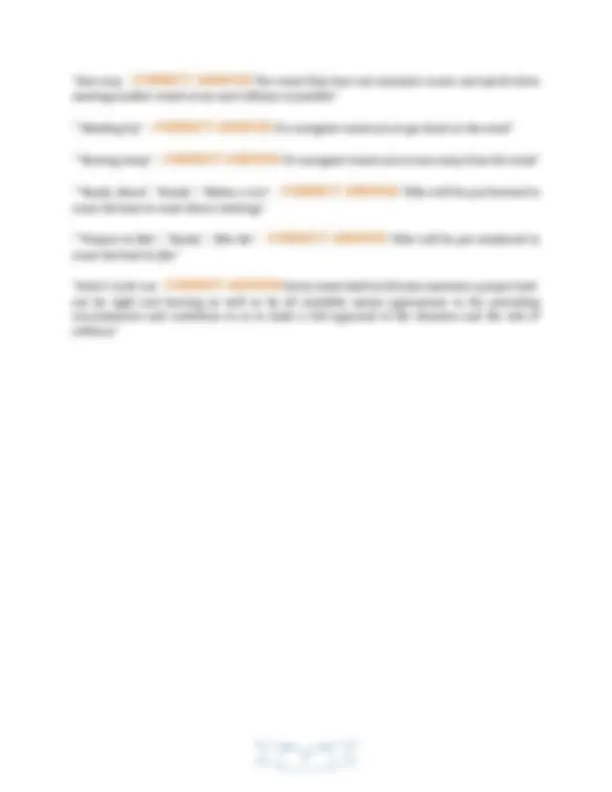Download ASA 101, BASIC KEELBOAT SAILING QUESTIONS and more Exams Physical Activity and Sport Sciences in PDF only on Docsity!
ASA 101, BASIC KEELBOAT SAILING QUESTIONS
WITH EXPLANATIONS OF ANSWERS LATEST.
“Hull - CORRECT ANSWER Watertight floating body of the boat that gives it form and houses
or supports every other part of the boat"
"Deck - CORRECT ANSWER Encloses the top of the hull and is generally horizontal"
"Transom - CORRECT ANSWER Transverse, vertical section that makes up the stern of the
boat, as high as the hull or as low as the waterline"
"Fairlead - CORRECT ANSWER A ring mounted on a boat to guide a rope, keeping it clear of
obstructions and preventing it from being cut or chafed"
"Fender - CORRECT ANSWER Used to keep something off or prevent a collision"
"Docklines - CORRECT ANSWER Ropes specifically made for use when securing the vessel to
the dock"
"Mainsail - CORRECT ANSWER Primary sail used to move the boat"
"Jib - CORRECT ANSWER Like the mainsail, it is controlled with sheets, one on either side of
the mast"
"Head - CORRECT ANSWER Bathroom"
"Tack - CORRECT ANSWER Change course by turning a boat's head into and through the
wind"
"Clew - CORRECT ANSWER The lower or after corner of a sail, haul these up into the mast for
furling"
"Foot - CORRECT ANSWER The bottom edge of a sail"
"Luff - CORRECT ANSWER The edge of a fore-and-aft sail next to the mast or stay"
"Leech - CORRECT ANSWER Back edge of a sail, diagonal"
"Downhaul - CORRECT ANSWER A rope used for hauling down a sail, spar, especially in
order to control a sail's shape"
"Freeboard - CORRECT ANSWER The distance from the waterline to the upper deck level,
measured at the lowest point of sheer where water can enter the boat"
"Heel - CORRECT ANSWER To lean or tip under the influence of the wind on sails, controlled
by ballast and underwater design of boat"
"Weather Helm - CORRECT ANSWER A tendency in a sailing ship to head into the wind if the
tiller is released"
"Skipper - CORRECT ANSWER The captain of a ship or boat"
"Helmsman - CORRECT ANSWER A person who steers a ship or baot"
"Crew - CORRECT ANSWER A group of people who work on and operate a ship"
"Head-to-Wind - CORRECT ANSWER Point of sail to describe orientation and relation to the
wind, a boat will be on either a port tack or a starboard tack"
"No-Sail Zone - CORRECT ANSWER A boat cannot sail directly into the wind, nor on a course
that is too close to the direction from which the wind in blowing"
"Close Hauled - CORRECT ANSWER By sailing at either the port or starboard edge of the no-
sail zone, the sails are pulled as close at possible to the boat's center"
"Close Reach - CORRECT ANSWER Turning the boat slightly further away from the wind, the
10:00 or 2:00 position"
"Beam Reach - CORRECT ANSWER The wind is blowing directly across the boat's beam, its
widest part, the 9:00 or 3:00 position"
"Broad Reach - CORRECT ANSWER Headed slightly downwind"
"Run - CORRECT ANSWER When the boat is going directly downwind at 6 o'clock"
"Sailing-by-the-Lee - CORRECT ANSWER "
"Navigational Signals: Two Blasts - CORRECT ANSWER Intention to direct course of vessel to
own port"
"Navigational Signals: Three Blasts - CORRECT ANSWER Indicates vessel's engines are going
astern (in reverse)"
"Navigational Signals: Five Blasts - CORRECT ANSWER Danger signal used when the other
vessel's intentions are not understood or its indicated course is dangerous"
"Navigational Signals: Prolonged Blast - CORRECT ANSWER (4 to 6 seconds) Indicates
restricted visibility"
"Masthead Light - CORRECT ANSWER White light placed over the fore and aft centerline of
the vessel"
"Sidelights - CORRECT ANSWER Green light on the starboard side and a red light on the port
side"
"Sternlight - CORRECT ANSWER White light placed as nearly as practicable at the stern"
"Towing Light - CORRECT ANSWER Yellow light having the same characteristics as a
sternlight"
"Keel - CORRECT ANSWER Heavy, fixed appendage on the bottom of the hull that not only
provides the sideways resistance, but also the vertical stability needed to counter the force of the wind on the sails that would otherwise push the boat sideways"
"Mast - CORRECT ANSWER Vertical metal or wooden pole that supports its primary sail, the
mainsail"
"Boom - CORRECT ANSWER Horizontal pole at the bottom of the mainsail, it swings from
one side of the boat to the other when the boat is turning through the wind"
"Gooseneck - CORRECT ANSWER Swivel connection on a sailboat by which the boom
attaches to the mast"
"Bow - CORRECT ANSWER Forward, front of the vessel"
"Stern - CORRECT ANSWER Aft, back of the vessel"
"Helm/Tiller - CORRECT ANSWER Attached to the rudder, it causes the boat to turn in the
opposite dirction"
"Rudder - CORRECT ANSWER A movable, fin-shaped part attached to the hull near the
stern"
"Cockpit - CORRECT ANSWER The area around and just in front of the tiller, where the crew
performs most boat-handling operations"
"Cabin - CORRECT ANSWER A compartment below the deck"
"Standing Rigging - CORRECT ANSWER Lines, wires, or rods which are more or less fixed in
position while the boat is under sail, in contrast to running rigging, which move and change fairly often"
"Shroud - CORRECT ANSWER Wire cables that help support the mast on either side, they are
sturdy to help when boarding and walking around the boat"
"Spreader - CORRECT ANSWER Horizontal, prevents shrouds from hitting the mast"
"Chainplate - CORRECT ANSWER Fasten a shroud or stay to the hull"
"Headstay/Forestay - CORRECT ANSWER Ensures the mast won't fall aft"
"Backstay - CORRECT ANSWER Ensures the mast won't fall forward"
"Stanchion - CORRECT ANSWER Holds lifelines"
"Lifeline - CORRECT ANSWER To provide for safety, wire cable that runs around the
perimeter of the deck about two feet above it"
"Pulpit - CORRECT ANSWER A raised platform in the bow"
"Winch - CORRECT ANSWER Always cranked clockwise, a hauling or lifting device
consisting of a rope, cable, or chain winding around a horizontal drum"
"Cleat - CORRECT ANSWER A T-shaped piece of metal or wood, to which ropes are attached"
"Block - CORRECT ANSWER Wood, metal, or synthetic casing that contains one or more
groove pulley called sheaves, primary component of running rigging, a device to change a lines direction"
"Roller Furler - CORRECT ANSWER Method of furling or reefing a sail by rolling it around a
stay or rotating a spar"
"Port - CORRECT ANSWER Left-hand side of vessel"
"Starboard - CORRECT ANSWER Right-hand side of vessel"
"Forward - CORRECT ANSWER Front, bow of vessel"
"Aft - CORRECT ANSWER Back, stern of vessel"
"Beam - CORRECT ANSWER Bearing projected at right-angles from the fore and aft lines,
outwards from the widest part of ship, define the maximum width of a ship's hull"
"Ahead - CORRECT ANSWER Front of the boat"
"Astern - CORRECT ANSWER Back of the boat"
"Windward - CORRECT ANSWER Side of boat that wind is coming from"
"Leeward - CORRECT ANSWER Side of boat opposite of where wind is coming"
"Draft - CORRECT ANSWER Determines the minimum depth of water a ship can safely
navigate, can be used to determine the weight of the cargo on board by calculating the total displacement"
"Luffing - CORRECT ANSWER If a boat turns to leeward too far, or sails "by the lee", the boat
can jibe accidentally if the lee side of the sail catches the wind, causing the boom to swing across the boat quickly"
"Port Tack - CORRECT ANSWER If the wind is coming from anywhere on the port side"
"Starboard Tack - CORRECT ANSWER If the wind is coming from anywhere on the starboard
side"
"Jibing - CORRECT ANSWER A turning maneuver, opposite of a tack, the stern passes
through the wind"
"Stand-on - CORRECT ANSWER The vessel that must maintain course and speed when
meeting another vessel at sea and collision is possible"
"Give-way - CORRECT ANSWER The vessel that does not maintain course and speed when
meeting another vessel at sea and collision is possible"
""Heading Up" - CORRECT ANSWER If a navigator wants you to go closer to the wind"
""Bearing Away" - CORRECT ANSWER If a navigator wants you to turn away from the wind"
""Ready About", "Ready", "Helms-a-Lee" - CORRECT ANSWER Tiller will be put leeward to
cause the boat to come about (tacking)"
""Prepare to Jibe", "Ready", "Jibe-Ho" - CORRECT ANSWER Tiller will be put windward to
cause the boat to jibe"
"Rule 5: Look-out - CORRECT ANSWER Every vessel shall at all times maintain a proper look-
out by sight and hearing as well as by all available means appropriate in the prevailing circumstances and conditions so as to make a full appraisal of the situation and the risk of collision"
















